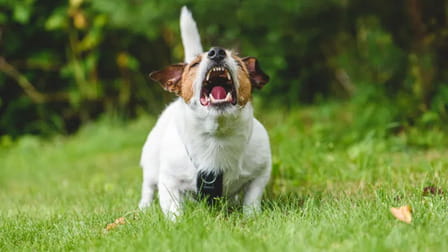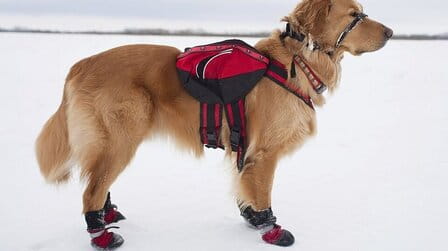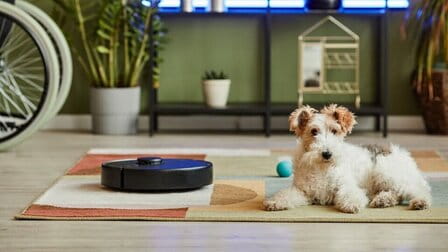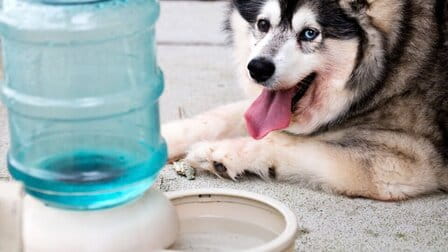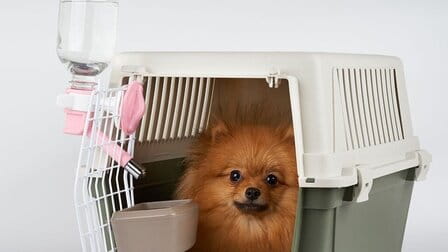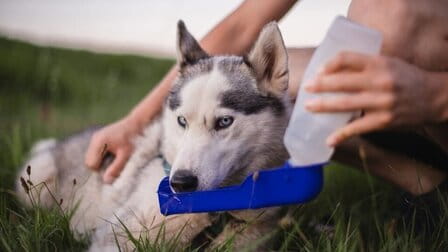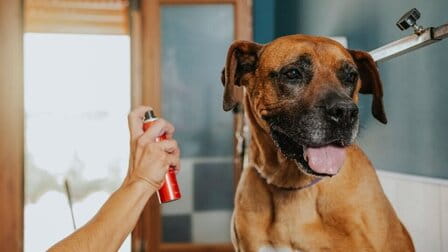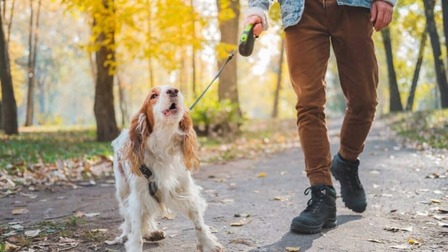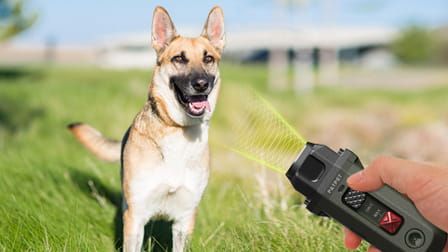Even if you take your dog to a professional groomer for a bath and haircut, it's important to learn and know how to brush your dog between visits. Brushing will help remove dead hair and remove fade patches and debris.
Besides, the distribution of natural oils in the pet's hair and stimulation of blood circulation near the surface of the skin. What's more, regular brushing allows you to check your dog for anything out of the ordinary and give the coat a careful look to remove wood mites or take care of minor cuts.
So how to brush your dog? How to improve the shine of pet hair?
Find out with us below!
1. Brushing with good technique
Steps to prepare the dog
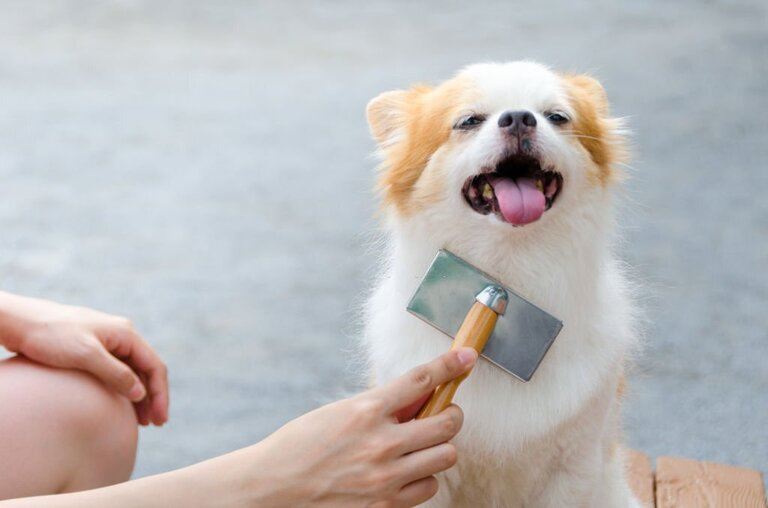
Banh needs to find a safe, quiet place to brush the dog's coat. If the weather is sunny, you also have the flexibility to let your pet enjoy the outdoors and make cleaning easier. Not only will this put your dog at ease and speak in a calm, reassuring voice throughout the grooming process.
Ask the dog to sit and then reward them. This is also a way to help you start better grooming.
Let your dog sniff the brush and tool in use before starting.
Create a system for brushing teeth

You should follow a regular schedule and brush short and medium-haired pets about once a week.
Long-haired dogs usually need daily brushing. For grooming steps, start at your dog's head and then work toward the tail. Brushing your coat the same way will help you not skip a step.

There are still some people who start with the tail and head forward which helps keep the very nervous dog calm, as they can't see what's going on at first. If you are going to bathe your dog, brush it first. The tangles become tighter and harder to remove when they get wet.
Spray on some hair conditioner

Often pets have very tangled or long hair that easily gets sticky, spray the pet's coat with a product like a mink oil before brushing. It will help loosen knots and tangles.
Using a rubber brush or comb

The rubber curry combs are great for paws, ears, and tails, but you have to be gentle. Using the rubber comb in gentle, circular motions all over the dog's body will help distribute the oil and keep the coat soft and shiny.
You should not use metal combs used to brush your dog's hair because they are used to clean the hair on other brushes. The metal curry comb is too harsh to use on your pet's delicate skin.
Use strong, but gentle strokes

On thick coats, brushing should start at the skin and brush outwards. Then start over, brushing in the direction of hair growth. If with other coats, brush in the same direction as hair growth. Brush the pet's fur close to the skin, but do not brush the hair to hurt the pet. As this can cause redness, the irritating part of the skin is known as a "brush burn", rest assured concerned because it can be treated by a veterinarian.
- The use of long claws for long-haired dogs.
- Use short strokes on dogs with short or shaggy hair.
- If using a soft-bristled brush, brush gently but quickly, in the direction of the pet's hair growth.
Brush in sequence each time

The hair on the dog's neck and legs should be brushed. If your dog has longer hair around the neck on the legs, you can use a comb to remove the knots before brushing. Then, gently brush the underbelly, sides, back, tail, hind legs, and tail.
- Take care when brushing your pet's delicate bottom.
- Do not brush directly on the skin.
- Brush your dog's face to avoid touching his face - brush his face with a damp cloth instead.
- Longer cunts can be lightly combed with a comb.
Brush your dog's ears

Cleaning your dog's ears weekly will help keep them comfortable and prevent ear infections. When your dog has long hair on his ears, trim it gently with scissors. In particular, examine the area closely for ticks, ticks, and fleas in the ear. Then, wrap a cotton ball or surgical pad soaked in ear cleaner, or a washcloth, around your finger and gently wipe the inside surface of your dog's ear.
- Avoid using water drops in the dog's ears because the water does not evaporate, which can easily lead to ear infections.
- Do not use Q-tips or try to insert anything into the ear canal, which can easily cause painful ear injuries.
- When you notice an unusual smell or discharge from your dog's ears, take him to the vet.
Take care of your dog’s feets

Keeping the dog's paws tidy not only looks good, but also reduces the amount of stuff that gets stuck in it like ledges, asphalt, icebergs, bugs, and tar.
The hair on the dog's paws can be carefully trimmed with scissors, with the hair on the bottom of their paws so that the hair is about the same length as the paws. The hair between the toes or the pads of the paws should not be trimmed, which can injure the dog if it moves suddenly.
Remove dead, frizzy hair

Brush long-haired dogs to remove loose hair. In it, you can use a small handheld vacuum if you are careful and let the dog not be afraid of noise. If your dog has a short, smooth coat like a Chihuahua or a Boxer, use chamois to polish their coat.
Tailor your grooming routine to your dog's breed

With so many different breeds, there are many different types of coats, and each has its grooming requirements.
Usually, we're all based on three main factors: short or long coat (over an inch), single or double coat, and hairless fur (longer tassels on the neck, ears, legs, and tail).
Breeds with long, silky single coats like the Maltese and Yorkshire Terriers are prone to tangles. It is advisable to brush these dogs daily, at least once every two days. Furry breeds such as Cocker Spaniels, Shih Tzus, Lhasa Apsos, Irish Setters, and Golden Retrievers, require regular brushing along with brushing.
Or double coat dogs like Pomeranians, Shetland Sheepdogs, Siberian Huskies, and Samoyeds, which will typically shed more than other dogs and have their undercoats combed during shedding season. Some short-haired breeds like Chihuahuas, Labrador Retrievers, and Greyhounds, can expect to last about two weeks between brushings.
Avoid excessive grooming

Regular brushing avoids lint or tangles but be careful not to brush too hard or with the wrong brush like a slicker on short-haired dogs, which can cause painful skin irritation.
Bathing too often can strip the skin of its natural oils, causing dry and itchy patches. Therefore, bathing without proper grooming can dry out the coat, causing it to become brittle and dry.
2. Removing mats and tangles
Apply conditioner directly to the mat

Apply a generous amount of commercial conditioner and massage into the affected area. When a small pad is not treated immediately, it should be reconsidered. Conditioner helps loosen tangles so that tangles can be removed more easily.
Untangle the mat

However, carpets can be very hard, contain a lot of dirt and hair, and get stuck in a dog's skin. Even a very small rug made of five or ten hairs can pull on the skin under a dog's arms and can cause an infection by moving bacteria around the genital areas.
From there, parasites like ticks and fleas also like to hide on the carpet, so you should always take care of them as soon as possible. Also, always try to untangle the rug with your hands or fingers before starting with the comb.
First, using the wide-tooth of the comb, hold the mat firmly in your fingers so as not to pull the dog's hair as you pull the mat.
Use the finer teeth of the comb once you've broken most of the mat.
Be patient with the dog and give it a break if necessary

This is a difficult process for your dog, once he moves or jerks while you're brushing him, it's possible to accidentally injure him. Or if you are rough or impatient while grooming your dog, there will be a barrier between you and your pet.
Note, most dogs will try to chew on a tangle of hair when it starts to bother them, so it may be quite sensitive at this point before you start.
Use scissors sparingly

When you can't untangle it, you can use scissors to cut it out. Then, put the comb between the tangled hair and the dog's skin, and then use the scissors to cut the coat, which will help you avoid cutting the dog's neck.
Reward the dog

At the end of their grooming session, reward your dog with a delicious meal to thank them, which will encourage them to look forward to the next grooming session.
Avoid shaving the dog's coat
With proper grooming, shaving of any breed is advised by a veterinarian or a trusted professional groomer.
You should not shave dogs with double coats, such as Pomeranians, Shetland Sheepdogs, Siberian Huskies, and Samoyeds. Since the dog's outer coat is double-coated, it protects them from extreme heat and cold, UV rays, and insect bites.
Instead, brush your dog's coat more thoroughly during the Spring and other shedding periods. If the undercoat is matted, resulting in air being unable to circulate between the outer coat and the skin, your dog will likely lose its ability to stay cool in warm weather.
Shaving the undercoat will not prevent hair loss. Especially with older dogs, the topcoat will not grow back after being shaved. They leave only a patchy, shaggy undercoat and no outer protective coat.
3. Opting for the right brush
Use a bristle brush for all hair types
For long-haired breeds, brush with longer bristles in more widely spaced rows. For shorter coats, choose a brush with shorter, closer bristles. Furthermore, for softer bristles, use a soft-bristled comb. If the hair is too coarse, choose a brush with stiff bristles.
Use a wire pin brush for long or curly coats

Wired pin brushes are made with or without rubber tips on the bristles. So try a brush if your dog has fluffy or curly hair, or medium to long hair.
Use a smooth brush to remove tangles

Some slick brushes have very fine bristles and are good at removing carpets, burrs, and tangles. Together with the wooden handle comb is used for this purpose.
Try scratching the undercoat on the thick coat
If your dog has a very thick coat with an insulating undercoat, like the Akita, this rake helps to remedy this. Shaving is very versatile and can be used on other dogs, or long-haired cats.
Using a rubber comb

Like the curry comb used to groom horses, this comb is good for short-haired breeds like Dobermans and Beagles.
Be careful when using the blade
Most shaving blades are designed to remove loose, dead hair. When you don't use them properly, they will remove healthy hair and worse than cut your dog's skin.
Use the right brush for your dog's breed
To choose the right brush for your dog's specific coat type. Brushes are designed to perform specific functions on certain types of bristles. Using the wrong brush for your dog's coat can cause skin irritation.
- Fine coats (Bull Terrier, Dachshund, Chihuahua) use a bristle brush every one to two weeks, brushing against the grain to loosen and remove dead hair.
- The double coat (Rottweiler, Chow, Husky, and Collie) uses weekly brushing throughout the year and more often during the shedding season. It is recommended to use a smooth brush to brush the undercoat, then brush the outer coat with the same brush. Or use a wide-tooth comb to comb through longer layers and detangle.
- Wire coats or broken coats (Airedales, Irish Wolfhounds) should be lightly combed over the dog's back, gently pulling out the hairs to thin the overgrown and wispy coat, cordless coats Stick to the skin like other hairs, this doesn't hurt the dog. Then, brush the coat in layers from the skin outwards with a sleek brush.
- Curly bristles (Poodle, Bichon Frise) brush the seeds with a fine bristle brush to create fluff, then bathe and dry while brushing with a slicker with the grain.
- Long coats (Shih Tzu, Lhasa Apso, Yorkshire Terrier, Maltese) use a comb to gently brush the hair in the direction of the hair, then use a soft bristle brush to sweep the entire coat.
- Flocking coat or Cording coat (Bergamasco, Komondor, or Hungarian Shepherd) whose coat is made of fur, not fur, which gradually clumps together to form natural "dreadlocks". Although they have long hair, dogs with thick coats are considered non-shedding. And you don't have to brush.
- The hairless coat (Mexican Hairless, Inca Orchid, Chinese Crested) with hairless breeds does not require brushing but you do need to bathe them regularly.
Conclusion
Indeed, you don't need a professional dog groomer, if one is skilled at grooming your pet that's fine too. There is some skill required if the dog's coat tends to become frayed.
Therefore, brushing is an essential part of a good grooming routine and helps keep your dog's coat healthy and looking good. Through How To Brush Your Dog, we believe that you can better understand pets and know how to please them.

